Machine learning in browser: ways to cook up a model
With ML projects still on the rise we are yet to see integrated solutions in almost every device around us. The need for processing power, memory and experimentation has led to machine learning and DL frameworks targeting desktop computers first. However once trained, a model may be executed in a more constrained environment on a smartphone or on an IoT device. A particularly interesting environment to run the model on is browser. Browser-based solutions may be used on a wide range of devices, desktop and mobile, online and offline. The topic of this post is how to prepare a model for the in-browser usage.
This post presents an end-to-end implementations of a model creation in Python and Node.js. The end goal is to create a model and to use it in a browser. I'll use TensorFlow and TensorFlow.js as main frameworks. One could train a model in Python and convert it to JS. Alternative is to train a model directly in javascript, hence omitting the conversion step.
I have more experience in Python and use it in my everyday work. I occasionally use javascript, but have very little experience in the contemporary front-end development. My hope from this post that python developers with little JS experience could use it to kick start their JS usage.



















